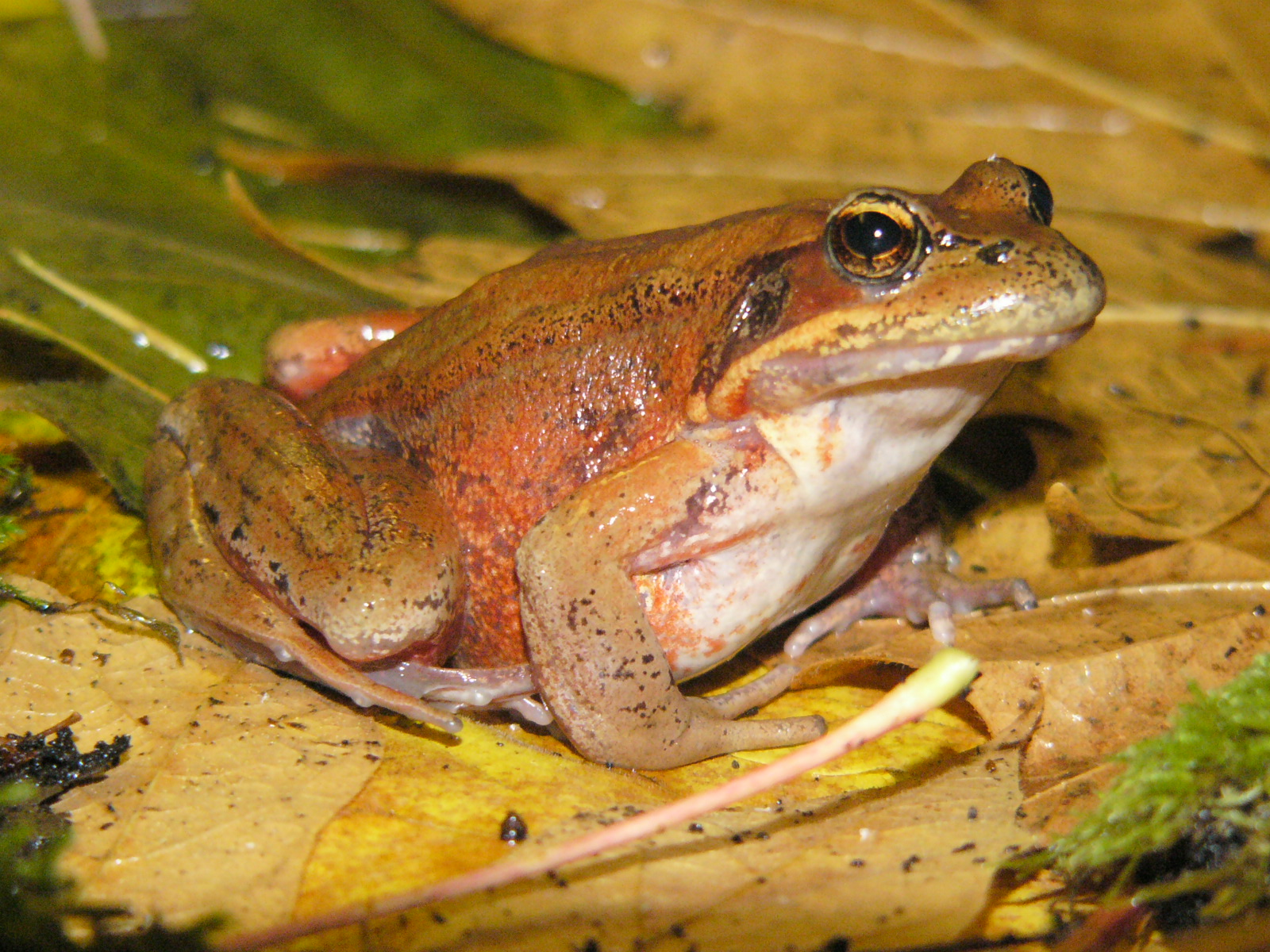Red-legged frogs in the Puget Sound watershed
The Northern Red-legged Frog is described here relative to its local behavior, habitat, threats and morphology.

Breeding
Historically, the breeding season of Rana aurora in the Puget Sound watershed begins in late January or February, and extends for two weeks to a month. Temperature variation characteristic of the Puget Sound can cause local populations to breed a week earlier than those living in the more interior areas, which are more prone to freezing (Hayes 2012).
Egg masses, which are large and easy-to-find, are laid on available wetland plants or over-hanging woody material in stormwater ponds (Yahnke 2011). One egg mass corresponds to one female, who only lays one egg mass annually (Yahnke 2011).
Habitat
Since predation by introduced game-fish may present a significant stress factor on Rana aurora, most ideal habitats for its breeding may be isolated wetlands. Many of these wetlands are seasonal (Richter and Azous 1995), and thus unlikely to harbor exotic aquatic predators like introduced warm-water fishes (Adams 1999) that require permanent water.
In one study, Rana aurora were most abundant in seasonally flooded areas associated with permanent wetlands and in temporary wetlands that hold standing water through at least late-July (Adams 1999). However, the species only occupies wetlands for two weeks to a month in order to breed. Afterwards, they migrate to upland forests usually at least a half-mile away (Mapes 2009).
Distribution
View estimated distribution in Puget Sound (IUCN)
View AmphibiaWeb maps with documented population occurrences
Threats
Threats: invasive species
Rana aurora are not officially considered threatened in Washington, but the presence of bullfrogs and the rarity of native frogs in permanent wetlands have long been used to infer that declines have occurred (e.g., Jameson 1956).
Introduced species like the American Bullfrog and several warmwater fish species, all largely limited to permanent wetlands, may hinder Rana aurora from using or colonizing permanent aquatic habitats (Adams 1999; Ostergaard 2001; Ostergaard et al. 2008; Richter et al. 2008; see also Licht 1969b). Work in Washington State to date has been unable to identify a negative Bullfrog effect on Rana aurora, although a negative fish effect has been documented (Adams 1999; Ostergaard 2001).
Exotic fishes that have been detected near Rana aurora in the region include sunfish (Lepomis spp), yellow perch (Perca flavescens), smallmouth bass (Micropterus dolomieui), and bullhead (Ictalurus sp.). Many of these fishes introduced to the West are efficient predators, and many amphibian larvae, including those of Rana aurora, are poorly adapted to coexist with them (Kats et al. 1988, Werner and McPeek 1994, Skelly 1996, Tyler et al. 1998). Exotic fishes are associated with permanent wetlands and hence the conservation of more ephemeral wetland habitats may have direct benefits for Rana aurora (Adams 1999).
Behavioral differences suggest Rana aurora’s resilience to American Bullfrog invasions. For example, the Oregon Spotted Frog, which occurs syntopically with Rana aurora, displays different escape behaviors that make them more vulnerable to American Bullfrog predation than is Rana aurora (Licht 1986). Rana aurora and American Bullfrogs were frequently found breeding in stormwater ponds (Ostergaard 2001, pers. obs.) and evidence from field experiments suggests that the two species can coexist (Pearl et al. 2004).
Threats: hydrology
Water level fluctuations caused by hydrological systems for agricultural and urban land uses can threaten the survival of developing Rana aurora eggs; especially during embryogeny (Reinelt et al. 1998; Ostergaard et al. 2008), egg masses oviposited during times of high water levels can become stranded by the receding effects of water fluctuations (K. Richter pers. obs.) and lead to consequent desiccation or freezing. Possible effects of urban and agricultural hydraulics on water velocities can also affect egg survival; eggs appear to have the lowest mortality in water velocities of less than 5 cm/second (K. Richter pers. obs.). Evidence suggests that stormwater ponds may reduce velocity of released stormwater in surface waters by retaining water (as in wet ponds), allowing sediments to settle out, and/or detaining water (Yahnke 2011). As such, stormwater ponds, especially those with direct access to terrestrial habitat (Yahnke 2011), may contribute towards successful reproduction of Rana aurora. Also, stormwater ponds are used by migrating Rana aurora and by juveniles emigrating from breeding and natal ponds as intermediates in traveling across the landscape (Yahnke 2011). They also serve as a refuge during long dry spells when breeding and natal ponds may dry out (Yahnke 2011). However, increased movement through open landscapes and roads due to the intrusion of developed landscapes into areas with stormwater ponds can increase Rana aurora stress levels and mortality (Yahnke 2011). As such, one of the largest threats to Rana aurora in the Puget Sound is habitat destruction (Kennedy p.2).
Threats: habitat loss
Rana aurora breed and rear in wetlands, and much of this habitat in the Puget Sound region is protected by development regulations. However, most upland forests, where Rana aurora spends most of its time, are outside of protected zones (Mapes 2009).
Morphology
Interior populations of Rana aurora exhibit more of the characteristic red wash than the less-brightly-colored coastal populations, which may be attributed to the coastal population’s regular occupation in shaded forests (Hayes 2012).
More information
Encyclopedia of Puget Sound Species Library
Works cited
Adams, Michael. “Correlated Factors in Amphibian Decline: Exotic Species and Habitat Change in Western Washington.” The Journal of Wildlife Management Oct. 1999: 1162-1171. Web.
Hayes, Marc. Email interview. April 2012. Senior Research Assistant at the Washington Department of Fish and Wildlife.
Hayes, Marc and Timothy Quinn and Klaus Richter and Joanne Schuett-Hames and Jennifer Serra Shean. “Maintaining lentic-breeding amphibians in urbanizing landscapes: the case study of the northern red-legged frog (Rana aurora).” Urban Herpetology. Society for the Study of Amphibians and Reptiles, 2008. 133-149.
Kennedy, Karen. “Life History – Rana aurora aurora.” <http://courses.be.washington.edu/LARCH/363/images/A4%20pdfs/frog-red-leg.pdf
Mapes, Lynda. “Sprawl flattens frogs, other amphibians struggling to survive.” The Seattle Times 2009. Web.
Yahnke, Amy Elizabeth. “Amphibian Reproduction and Water Quality in Stormwater Ponds.” Diss. University of Washington, 2011. Print.

